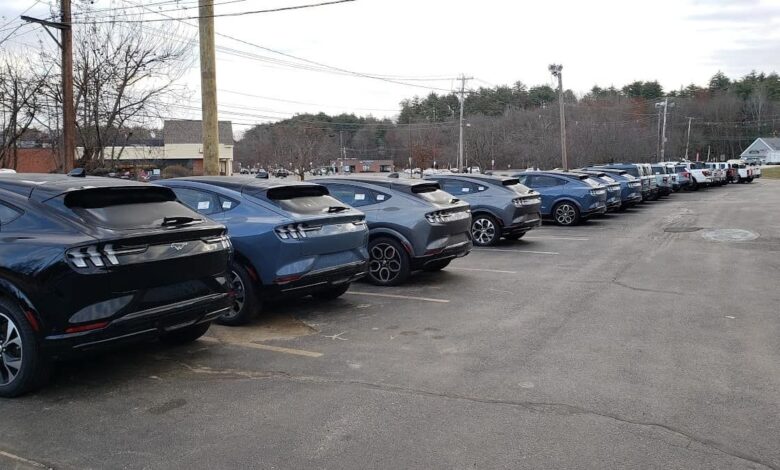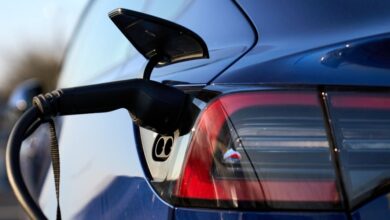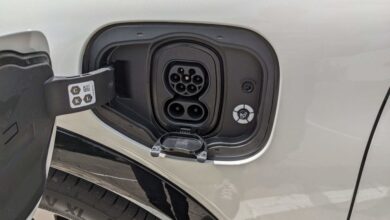Ford and Hyundai Post Big EV Single-Model Numbers In May – Some Context

Every delivery report from every automaker seems to boast “record sales…” of one model or one type of vehicle. When it comes to battery-electric vehicles (BEVs), the press is mainly bluster. The truth is that there are two BEVs in America that sell at mainstream volumes, the Tesla Model Y and the Tesla Model 3. If all the remaining EV models were gas-powered, they would be considered an abject failure and immediately canceled. Now for the good news.
Up until May, most automakers’ EVs, aside from Tesla’s two successful models, were cruising along at around 2,000 to around 3,000 units sold per month. Those are tiny numbers for four-door family vehicles, crossovers, and SUVs. Let’s use the Toyota RAV4 as a contrasting example. The RAV4 is typically delivered at a rate of roughly 45,000 per month in the U.S. market. Within the RAV4’s total, Toyota delivers about half of those with electrified powertrains, either as hybrid-electric or plug-in hybrid-electric. The Honda CR-V is similar. Honda delivers roughly 35,000 per month, and just over half are electrified hybrid-electric versions. So, green crossovers sell robustly, just not in fully electric versions.
The delivery numbers for May of 2024 are now in, and both Ford and Hyundai had a single model each that passed the 4,000 mark by quite a bit. Ford delivered 4,255 Mustang Mach-Es, and Hyundai delivered 4,449 Ioniq 5s. Bravo to both companies. Both sold less than 3,000 units of those models in May of last year. So, passing 4,000, and not by a little, is a big deal. We’ve tested both of these five-door crossovers (or hatchback cars if you prefer that description), and we found a LOT to like about each. In a direct comparison with the Tesla Model Y, we preferred the Mustang Mach-E in many ways. The Ioniq 5 is simply collecting a pile of awards and is an industry favorite. It is well-known as the EV that can charge the quickest in its peer group.
Why the Big Month?
One question we don’t know the answer to is, “Why was May better than prior months for these two models?” It may be that incentives and low-cost trims helped – a lot. Both brands have been discounting and offering lease deals on these two models. Cut the price enough, and buyers will react.
Were the bumps in deliveries due to a new change or trim? We don’t think the timing works out. Hyundai is offering a new special N trim of the Ioniq 5, but we don’t see any evidence it is actually selling in large numbers – yet. Ford has made substantive changes to the Mach-E, but as far as we know, they are not yet being shipped. Neither automaker issued a press release saying the product changes were to be credited, and usually, they do if it is the case. Hyundai did mention a new marketing campaign. Price is part of marketing, right?
What About Other Models at Ford and Hyundai?
Both Ford and Hyundai have a nice paddock of BEVs now. Ford has the Lightning truck, and its E-Transit work van. Hyundai has the Ioniq 6, which is a car version of the Inoiq 5 (oversimplifying here, but it’s true). And Hyundai has a Kona EV, but it sells in such small numbers Hyundai does not even reveal the numbers. Both brands also have successful hybrid-electric vehicles and PHEVs.
Ford’s other EVs are selling well, too. The F-150 Lightning came in at 3,260, and the E-Transit at 1,451 units in May. Both were around double last May’s deliveries. Both are also small fractions of the total sales of those models. Hyundai’s Ioniq 6 came in at 1,099. Slightly up from last May.
Not Every Brand’s BEVs Had a Strong Month
VW’s ID.4 is in real trouble. It follows the same blueprint that the Ford and Hyundai mentioned above, but is heading down, not up, in deliveries. We have not seen a May delivery report for VW, but its Q1 numbers showed a 37% decline in deliveries of the ID.4. It has been delivered at a rate of roughly 2,000 units per month. The Toyota bZ4X is also slow, still selling at under 1,000 units per month. Subaru’s Soltera is being delivered at an approximately 1,500 unit per month rate and is just now exiting its ramp-up. In Volvo’s May deliveries report, the company did not report how many BEVs it sold. Instead, it simply adds all its plug-in models together and reports what percent of total sales those represent. Why be cagey if the BEVs are thriving?
Mandates Matter
California and other states are using mandates to push automakers toward battery-electric vehicles. It should be no surprise to anyone that automakers are reporting growing BEV deliveries. They have to meet the mandates, and they will. Does this mean that middle-income families are flocking to BEVs? It does not.
What To Look For In Delivery Reports
The real champagne toast moment will arrive when BEVs start to sell at the same rate popular models in their size and type categories do. So, when Ford and Hyundai have a battery-electric model that has the same delivery volumes as the Escape (15K per month) and the Tucson (17k per month), and maintains those deliveries for a stretch of a year or so, we will know that EVs other than a pair of Teslas are really succeeding with mainstream buyers.
Conclusion – Celebrate the Small Victories
It’s possible that battery-electric vehicles will have a big moment and that Americans will suddenly move en masse toward them. That has not happened. About 93% of new vehicle shoppers drive home in a vehicle that is not battery-electric. This has been true now for well over a year. Should BEV advocates celebrate the small victories, like Ford and Hyundai passing the 4,000 unit per month mark together? Absolutely, and we should also be sure to remember that Ford and Hyundai’s two BEVs are outstanding to drive. Here’s to hoping that Ford and Hyundai now have seven more consecutive 4,000+ units per month deliveries to celebrate. That would make 2024 a banner year.
If you’d like to add a comment under this story, please note that our comments section has returned and is in bold red at the bottom of the page.
John Goreham is an experienced New England Motor Press Association member and expert vehicle tester. John completed an engineering program with a focus on electric vehicles, followed by two decades of work in high-tech, biopharma, and the automotive supply chain before becoming a news contributor. In addition to his eleven years of work at Torque News, John has published thousands of articles and reviews at American news outlets. He is known for offering unfiltered opinions on vehicle topics. You can connect with John on Linkedin and follow his work at our X channel. Please note that stories carrying John’s by-line are never AI-generated, but he does employ Grammarly grammar and punctuation software when proofreading.
Images by John Goreham







